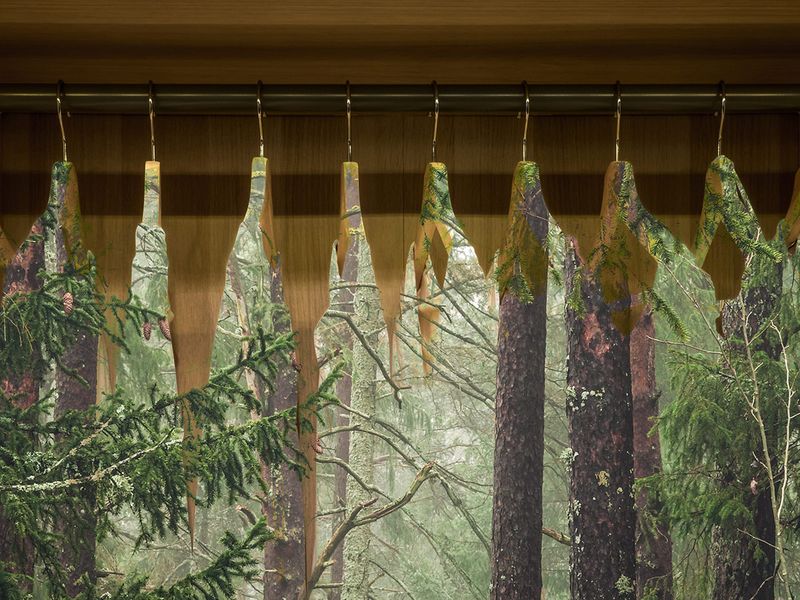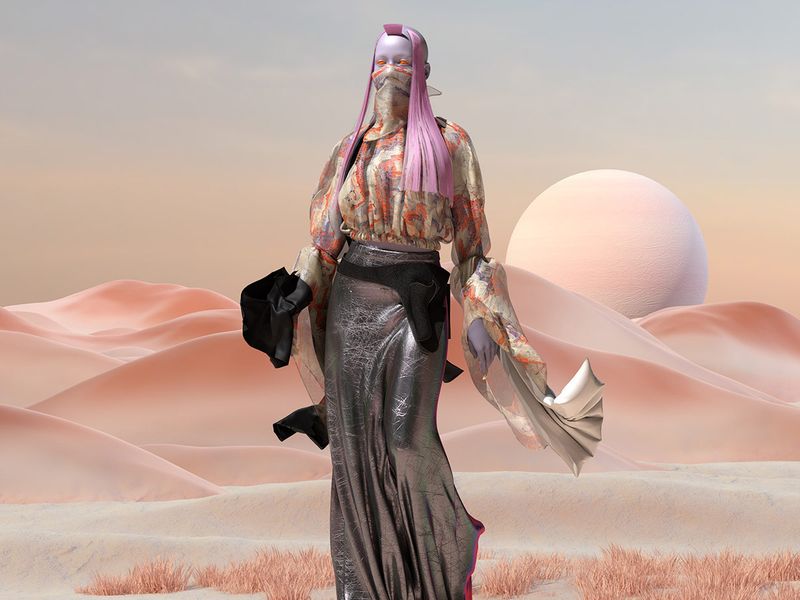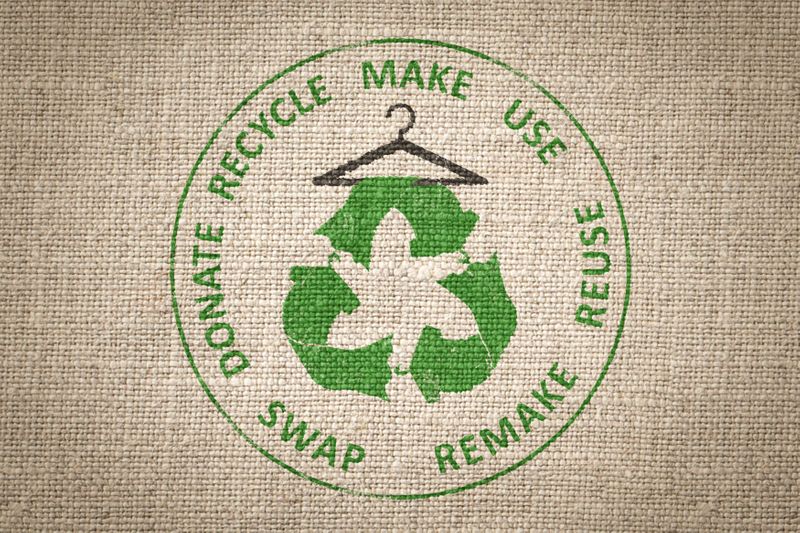30 years into the future, what are the clothes that will populate our daily lives?
Back in 1995, a cult favourite rom-com movie, Clueless, saw the fashion-savvy protagonist, Cher Horowitz, pick out her daily school outfit on a software that digitally changed outfits on her picture. For many of us, thinking of futuristic fashion also brings to mind sci-fi movies, androids and metallic, geometric designs in cold industrial cityscapes – not to mention, fire-proof, rip-proof, bulletproof clothing designed for superheroes in movies such as Incredibles. It certainly has one wondering if such options may be available for us to buy one day.
That reality has inched closer to us. For trends about fashion from the future, Gulf News speaks to famed celebrity fashion designer, Julien MacDonald OBE, previously chief designer at Givenchy, whose atelier has regularly dressed the likes of Beyonce, JLo, Shakira and the Kardashians. We also met with Fahed Ghanim, CEO of Majid Al Futtaim Lifestyle about where fashion is heading in the UAE. They spoke to Gulf News as part of the Future of Fashion panel at the UK Pavilion, at Dubai Expo 2020.
1. Green clothing

Image Credit: Shutterstock
Not the colour, but a reference to clothing that is ethically made and sourced – with recyclable or recycled textiles, non-toxic dyes and sufficiently paid workers.
We now live in a world where pretty outfits worn by online celebrities are instantly replicated in affordable forms for the public – ready to be shipped across the globe as per your heart’s desire. Influencers are known for their OOTD’s or Outfit of the Day’s, and in fact, a UK-based environmental charity, Hubbub, found during a poll in 2017 that 1 in 6 young people don’t feel that they can wear an outfit again if they have posted it on their social media. According to digital trend analysis software, Kepios, there are 4.55 billion social media users around the world – around 58 per cent of our total population.
Ask yourself, when you buy clothes in a boutique or a mall – where does this clothing come from, where does my dress come from? Was it made in China, was it made in India? Is it cotton, is it polyester? Is it green fabric, am I buying sustainable clothes – or am I buying clothing that damages the planet and affects people’s lives?
– Julien MacDonald
But as unethical labour practices of often underpaid, overworked and exploited workers fueling this ‘fast fashion’ trend have been coming to light, the environmental and social costs of producing low-quality synthetic, non-biodegradable clothing is also becoming a concern. In 2019, a report by predictive analytics company, First Insight found that 62 per cent of Generation Z entering the workforce that year preferred buying from sustainable brands.
Ghanim recounts his own observation towards the shift to sustainability: “Brands are demanding that factories producing their products in Bangladesh, in India, in Sri Lanka, for example, deliver on minimal standards of employee welfare. In the past, they didn’t know. There is also a pull for customers saying, we hold you accountable for the full supply chain. We cannot say ‘I don’t know’ anymore.”
Virendra Saklani/Gulf News
MacDonald adds that he has noticed that young designers are more conscious of the materials they use these days.
He says, “I think it’s up to everybody as a consumer to purchase clothes that have ethnical values.
“Ask yourself, when you buy clothes in a boutique or a mall – where does this clothing come from, where does my dress come from? Was it made in China, was it made in India? Is it cotton, is it polyester? Is it green fabric, am I buying sustainable clothes – or am I buying clothing which damages the planet and affects people’s lives?”
Some websites that can help your decisions are Rank a Brand, the Environmental Working Group, Higgs Index, BetterCotton initiative and the Fashion Transparency Index.
2. ‘Screenwear’ not Streetwear

Image Credit: Supplied/The Fabricant
Say hello to a new era of clothing… that cannot actually be worn. Confused? So were we, but if you play video games or are a regular snapchat user, you have already come across these digital garments.
Remember dressing or sometimes even paying money to change outfits for your beloved game characters, whether on Fortnite or your penguin character on Club Penguin? Snapchat users will also be familiar with the Ralph Lauren collection that can be used to dress our very own personal bitmojis in-app.
It’s the same idea, except created to dress us for our digital presence.
Digital clothing, meticulously animated garments for on-screen figures counters the effects of OOTDs (Outfit of the Day) and waste from constantly changing and disposing of outfits after posting them online. Now, instead of actually buying and wearing clothes for your fashionable photo, you can purchase a non-fungible token for your dress of choice from a digital fashion house, who will then realistically render it onto your photo for a dynamic digital image.
Michaela Larosse, Head of Content and Strategy for digital fashion house, ‘The Fabricant’, explains the concept, adding that back in 2019, the new owner of Iridescence was digitally dressed in the space and continues to wear it in virtual spaces.
It is an innovation that allows fashion to operate more sustainably and is embraced by Gen Z and youth who have grown-up within the digital world. Our planetary reality dictates that we don’t need any more physical garments to be created, and wasted, for interactions that take place on screens.
– Michaela Larosse, Head of Content and Strategy for digital fashion house, ‘The Fabricant’
Ghanim says, “I think that makes sense online. There is this trend where people want to look good on social media and they put on various outfits.
“Over time, you see a very high percentage of waste – so definitely, digital fashion can come in and reduce the trend of waste.”
3. RVR – Real items made Virtual then shoppable in Reality.
Sound familiar? Just like the Ralph Lauren-Snapchat collaboration, this subsection of digital fashion sees brands digitise their collections for customers to engage with first, along with the option to buy them. Back in 2019, Burberry launched an online game called ‘B Bounce’ where consumers could customise a cute deer avatar with an outfit from their monochrome collection. The winner could then win a real jacket from the collection.
This uses what is called the endowment effect: When someone has taken ownership of an object, their perceived value of it increases. Balenciaga’s launch of their Fall 2021 collection through a futuristic video game ‘Afterworld: The Age of Tomorrow, 2031’ last year reflects this trend, as customers can dress characters in the collection in an icy cyber-punk style world complete with platinum blond hair, metalliic puffer jackers and geometric sunglasses.
Another popular example is the interactive fashion styling app on iOS, Drest, where you can play fashion designer and dress avatars by buying virtual goods from hundreds of luxury brands. Peers can grade looks, you can curate collections and also buy the products physically. A 2020 collaboration with Wonder Woman 1984, saw the movie’s main outfits available for players to use, complete with backgrounds closely resembling the film itself.
4. Capsules

Image Credit: Shutterstock
Not wearing capsules per se, but housing our wardrobes in one under the minimalism trend. A capsule wardrobe is a personal collection of your favourite classic clothing pieces – small, essential and timeless. As your signature wardrobe, you can then accessorise this during the traditional fashion seasons to refresh your look.
MacDonald’s capsule wardrobe of choice? He says, “For me, it would definitely have to be a pair of black trousers or a pair of jeans. It’d have to be a t-shirt – I live in a t-shirt, preferably all black. I only wear black – so my timeless wardrobe is very, very easy.”
He also offers advice for creating your own, ”Buy things that you know that you love, and will wear many, many times. I think when creating a capsule wardrobe, find colours that are not too crazy, colours that you will feel like wearing every day. Some days you wake up and you go, “Oh my god, I’m not really in the mood for colour – I just want to wear like black or beige.
“But some days, you want to be colourful. The problems with colours is you have to be in the right mood to wear them.”
What about special occasions? He adds, “You can just buy one dress that you can wear to many occasions. Do you need to buy three dresses, when you know one will do the job?
“What designers and people are trying to say is buy clothes only when you need to buy them.”
5. TRU – Thrifting, Recycling, Upcycling

Image Credit: Shutterstock
“I’m going to pop some tags, only got 20 dollars in my pocket,” sings Macklemore in his 2012 hit song, Thrift shop, that calls thrifting ‘freakin awesome’ and perhaps well represents the Gen Z passion for it. In fact, a 2019 Wall Street Journal report found that, of 15 million users of Depop, the well-loved preloved fashion platform – 90 per cent were under the age of 26.
The idea of thrifting, as well as recycling and upcycling ties into the push for a circular fashion economy. The idea is that such practices will ensure a fashion production chain that comes full circle with zero waste and pollution, as a counter to linear, earth-choking retail pathways of clothes quickly disposed in landfills.
Macdonald says, “I thinking upcycling and recycling is amazing. I think it’s really exciting because when you say, recycling – it doesn’t mean always wearing old clothes. It means kind of changing the way that you wear your clothes.”
We looked into trends, what customers are looking for and what we need to offer. The theme of sustainability came in quite strong, and we brought a lot of brands who either upcycle of source responsibly, who really work to impact their economies – empowering people, rethinking resources and changing lives.
– Fahed Ghanim, CEO, Majid Al Futtaim Lifestyle
Ghanim tells us more about the creation of the THAT concept store in Mall of the Emirates, which has a designated upcycling hub: “We looked into trends, what customers are looking for and what we need to offer. The theme of sustainability came in quite strong, and we brought a lot of brands who either upcycle of source responsibly, who really work to impact their economies – empowering people, rethinking resources and changing lives.”
If you’re looking for thrift stores in the UAE, here’s a list of where you can visit.
Ghanim recounts his own experience upcycling: “I was quite happy to give a second life to shoes and my wife’s bags. You see people appreciating these [products] more.”
6. Functional ActiveWear

Image Credit: Unsplash/Benjamin Huggett
Especially in the field of performance fabrics worn for sports, fabrics are now designed to have extra beneficial attributes. Antimicrobial and antiviral clothing, initially widely used in hospitals are now being released in collections for the public.
Ghanim adds, “I know there’s a lot of companies developing technical fabrics that deal with body odour, and sweat.”
Here’s a quick list of some novel fabric features, in addition to beloved sweat-proof and waterproof active wear:
• Intelligent temperature regulating fibre that keeps you warm when you are cold, and cools you down when temperatures are hot
• Colour-changing fabrics using colorimetric dyes to detect chemical changes on your body and air
• Mosquito-repellent fabric
• Permanently fragranced fabric




